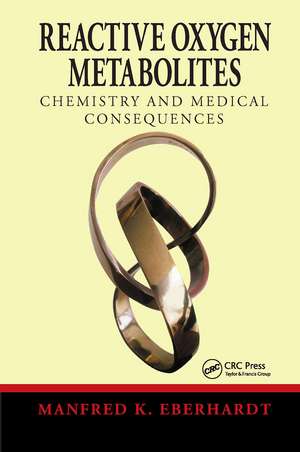Reactive Oxygen Metabolites: Chemistry and Medical Consequences
Autor Manfred K. Eberhardten Limba Engleză Hardback – 21 iul 2000
Reactive Oxygen Metabolites brings the subject within the grasp of even those with little preparation in chemistry. From the basic chemistry of radicals through the pathology, the author provides a clear and thorough introduction to ROMs and their importance to human health and disease. Exhaustively researched and referenced, this highly readable work will give you the ability to critically analyze and evaluate many pathological problems arising from the chemistry of ROMs and reduce them to their lowest common denominator. It is the ideal vehicle for people who need to understand the importance of reactive oxygen and nitrogen species in human health and disease but have neither the time, the inclination, nor perhaps the background to work their way through the mountain of original literature.
Preț: 1358.61 lei
Preț vechi: 1824.49 lei
-26% Nou
259.99€ • 269.90$ • 216.80£
Comandă specială
Livrare economică 03-17 martie
Specificații
ISBN-10: 0849308917
Pagini: 608
Ilustrații: 100 b/w images and 3 tables
Dimensiuni: 156 x 234 x 39 mm
Greutate: 1 kg
Ediția:New.
Editura: CRC Press
Colecția CRC Press
Locul publicării:Boca Raton, United States
Public țintă
ProfessionalCuprins
THE PROS AND CONS OF LIVING IN AN OXYGEN ATMOSPHERE
BASIC CHEMISTRY OF RADICALS
Definition and History
Formation of Radicals
Reactions of Radicals
CHEMISTRY OF OXYGEN-DERIVED RADICALS
Historical Perspective
Definitions
One-Electron Reduction of Oxygen
Superoxide Radical Anion
Peroxyl Radicals
Hydroxyl Radical
CHEMISTRY OF ELECTRONICALLY EXCITED STATES
Singlet Oxygen
Excited Carbonyl Compounds
FORMATION OF REACTIVE OXYGEN METABOLITES IN VIVO
Introduction
Mitochondrial Electron Transport
Hemoproteins
Flavin-Linked Oxidases
The Microsomal Enzymme System
Phagocytosis
Electronically Excited Carbonyl
Compounds via Enzymatic Oxidations
Endothelium-Derived Relaxing Factor (EDRF)
REACTIONS OF REACTIVE OXYGEN METABOLITES WITH IMPORTANT BIOMOLECULES
General Remarks about Oxygen Radical Investigations
Reactions of Hydroxyl Radicals with Fatty Acids
Mechanism of Lipid Peroxidation-Induced Pathogenesis
Chemistry of Oxygen Radical Damage to DNA
DNA Damage via Electronically Excited States
Biological Markers for in vivo Oxidative Damage
NITRIC OXIDE
Chemical Formation of Nitric Oxide
Chemistry of Nitric Oxide
Important Reactions in the Deactivation of Nitric Oxide
Reactions of Nitrogen Dioxide
Nitric Oxide and Superoxide Dismutase
The Chemical Nature of EDRF
Chemistry of Peroxynitrite-Peroxynitrous Acid
The Role of Peroxzynitrite-Peroxynitrous Acid in vivo
Protective Effect of Nitric Oxide in Oxygen Radical Induced Damage
Toxicity of Nitric Oxide via Release of Fe(II) from Ferritin
Protein Derived Radicals and Nitric Oxide
ANTIOXIDANTS
Introduction
Superoxide Dismutases
Reactions of Oxygen and Oxygen Radicals with Ascorbic Acid
Uric Acid
Melatonin
Vitamin E
Antioxidan and Prooxidant Activity of Flavonoids
Carotenoids
Proteins which form Complexes with Transition-Metal Ions
Peptides as Antioxidants
Do Antioxidants Prevent Diseases in vivo?
PATHOLOGICAL PROCESSES INVOLVING REACTIVE OXYGEN METABOLITES
Introduction
Aging and Cancer
Inflammation, Cell Division, and Cancer
Neurodegenerative Disorders
Lung Diseases
Atherosclerosis
Ischemia-Reperfusion
Oxidative Stress and Lifestyle
CONCLUSION
REFERENCES
Recenzii
--Angel A. Roman Franco, M.D.
"…To write a single-authored, compact introductory text which encompasses all the different aspects of ROM chemistry, biology and pathology is a challenging task: the author has succeeded formidably…The text is throughout well referenced. It not only represents an easy to read overview of this complex interdisciplinary subject of biological and medical relevance, but serves also as a fountain of valuable information for more in-depth considerations. As an introductory text, this book should have wide appeal and is highly recommended. It should be a welcomed text for a special topic course at the interphase of chemistry, biology and medicine: I certainly would adopt it for my course at the advanced undergraduate and graduate level."
- Prof. Dr. W. Adam, Institut für Organische Chemie der Universität Würzburg
Descriere
In recent years, the field of radical chemistry has undergone explosive growth. Although its roots lie in organic chemistry, the implications of its findings are having enormous impact in a broad range of disciplines, and we now have evidence for radical involvement in over 100 diseases. As important as this is, however, the subject of radicals and reactive oxygen metabolites (ROMs) is complex and barely touched upon in the curriculum of medical schools.
Reactive Oxygen Metabolites brings the subject within the grasp of even those with little preparation in chemistry. From the basic chemistry of radicals through the pathology, the author provides a clear and thorough introduction to ROMs and their importance to human health and disease. Exhaustively researched and referenced, this highly readable work will give you the ability to critically analyze and evaluate many pathological problems arising from the chemistry of ROMs and reduce them to their lowest common denominator. It is the ideal vehicle for people who need to understand the importance of reactive oxygen and nitrogen species in human health and disease but have neither the time, the inclination, nor perhaps the background to work their way through the mountain of original literature.
